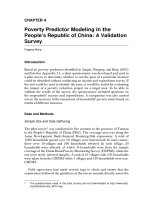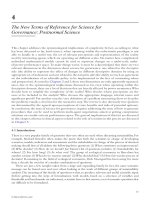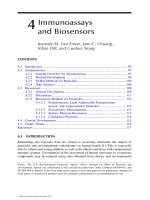HRM 5th chapter 4 job analysis, employee involvement, and flexible work schedules
Bạn đang xem bản rút gọn của tài liệu. Xem và tải ngay bản đầy đủ của tài liệu tại đây (700.22 KB, 56 trang )
Job Analysis, Employee
Involvement, and
Flexible Work Schedules
Managing Human Resources
Belcourt * Bohlander * Snell
Copyright © 2008 by Nelson, a division of Thomson
Canada Limited. All rights reserved.
5th Canadian edition
PowerPoint Presentation by
Monica Belcourt, York University and
Charlie Cook, The University of West Alabama
Objectives
After studying this chapter, you should be able to:
1. Discuss the relationship between job requirements and the
performance of HRM functions.
2. Indicate the methods by which job analysis typically is
completed.
3. Identify and explain the various sections of job descriptions.
4. Provide examples illustrating the various factors that must be
taken into account in designing a job.
5. Discuss the various job characteristics that motivate
employees.
Copyright © 2008 by Nelson, a
4–2
Objectives
(cont’d)
After studying this chapter, you should be able to:
6. Describe the different group techniques used to maximize
employee contributions.
7. Differentiate and explain the different adjustments in work
schedules.
Copyright © 2008 by Nelson, a
4–3
What is a Job?
• Job
A group of related activities and
duties.
Job
Job
• Position
The different duties and
responsibilities performed by only
one employee.
• Job Family
Job
Job
Job
Job
Job
Job
A group of individual jobs with
similar characteristics.
Copyright © 2008 by Nelson, a
4–4
Job Requirements
• Job Specification
Statement of the needed knowledge, skills, and abilities (KSAs)
of the person who is to perform the job
• Job Description
Statement of the tasks, duties, and responsibilities (TDRs) of a
job to be performed
Copyright © 2008 by Nelson, a
4–5
Relationship of Job Requirements
to Other HRM Functions
Job Requirements
Job Requirements
Recruitment
Recruitment
Determine
Determinerecruitment
recruitmentqualifications
qualifications
Selection
Selection
Provide
Providejob
jobduties
dutiesand
andjob
job
specifications
for
selection
process
specifications for selection process
Performance
Performance
Appraisal
Appraisal
Provide
Provideperformance
performancecriteria
criteriafor
for
evaluating
employees
evaluating employees
Training
Trainingand
and
Development
Development
Determine
Determinetraining
trainingneeds
needsand
anddevelop
develop
instructional
programs
instructional programs
Compensation
Compensation
Management
Management
Provide
Providebasis
basisfor
fordetermining
determining
employee’s
rate
employee’s rateof
ofpay
pay
Copyright © 2008 by Nelson, a
4–6
Job Analysis
• Job Analysis
The process of obtaining information about jobs by determining
what the duties, tasks, or activities of jobs are.
HR managers use the data to develop job descriptions and job
specifications that are the basis for employee performance
appraisal and development.
The ultimate purpose of job analysis is to improve organizational
performance and productivity.
Copyright © 2008 by Nelson, a
4–7
The Process of Job Analysis
Figure 4.1
Copyright © 2008 by Nelson, a
4–8
Determining Job Requirements
Nature of:
Basis for:
Job Analysis
••
••
••
What
Whatemployee
employeedoes
does
Why
Whyemployee
employeedoes
doesitit
How
Howemployee
employeedoes
doesitit
•• Determining
Determiningjob
jobrequirements
requirements
Job Description
••
••
Summary
Summarystatement
statementof
ofthe
thejob
job
List
Listof
ofessential
essentialfunctions
functionsof
ofthe
the
job
job
••
••
••
Employee
Employeeorientation
orientation
Employee
Employeeinstruction
instruction
Disciplinary
Disciplinaryaction
action
••
••
••
Recruitment
Recruitment
Selection
Selection
Development
Development
Job Specification
•• Personal
Personalqualifications
qualificationsrequired
required
in
interms
termsof
ofskills,
skills,education
educationand
and
experience
experience
Copyright © 2008 by Nelson, a
4–9
Job Analysis and Essential Job Functions
• Essential Functions
Statements in the job description of job duties and
responsibilities that are critical for success on the job.
A job function is essential if:
The
position exists to perform the function.
A limited
number of employees are available to
perform the function.
The
function is specialized, requiring needed
expertise or abilities to complete the job.
Copyright © 2008 by Nelson, a
4–10
Performing Job Analysis
1. Select jobs to study
2. Determine information to collect: Tasks,
responsibilities, skill requirements
3. Identify sources of data: Employees,
supervisors/managers
4. Methods of data collection: Interviews,
questionnaires, observation, diaries and records
5. Evaluate and verify data collection: Other
employees, supervisors/managers
6. Write job analysis report
Copyright © 2008 by Nelson, a
4–11
Gathering Job Information
• Interviews
• Questionnaires
• Observation
• Diaries
Copyright © 2008 by Nelson, a
4–12
Controlling the Accuracy of Job Information
• Factors influencing the accuracy of job
information
Self-reporting exaggerations and omissions by employees and
managers
Collecting information from a representative sample of
employees
Capturing all important job information
Length
of job cycle exceeding observation period
Lack of access to job site for personal observation
Lack of familiarity with the tasks, duties, and
responsibilities of a job
Ongoing changes in the job
Copyright © 2008 by Nelson, a
4–13
Popular Approaches to Job Analysis
Functional
FunctionalJob
Job
Analysis
Analysis
Position
PositionAnalysis
Analysis
Questionnaire
Questionnaire
Critical
CriticalIncident
Incident
Method
Method
HRIS
HRISand
andJob
Job
Analysis
Analysis
Copyright © 2008 by Nelson, a
4–14
Approaches to Job Analysis
• Functional Job Analysis (FJA)
Quantitative approach to job analysis that utilizes a compiled
inventory of the various functions or work activities that can
make up any job.
Assumes that each job involves three broad worker functions:
(1) data, (2) people, and (3) things.
Copyright © 2008 by Nelson, a
4–15
Difficulty Levels of Worker Functions
DATA (4TH DIGIT)
PEOPLE (5TH DIGIT)
THINGS (6TH DIGIT)
0 Synthesizing
0 Mentoring
0 Setting up
1 Coordinating
1 Negotiating
1 Precision working
2 Analyzing
2 Instructing
2 Operating-controlling
3 Compiling
3 Supervising
3 Driving-operating*
4 Computing
4 Diverting
4 Manipulating
5 Copying
5 Persuading
5 Tending
6 Comparing
6 Speaking-signalling*
6 Feeding-offbearing*
7 Serving
7 Handling
8 Taking instructions—helping*
More
Less
*Hyphenated factors are single factors.
Figure 4.2
Source: U.S. Department of Labor, Employment and Training Administration, Revised
Handbook for Analyzing Jobs (Washington, DC: U.S. Government Printing Office, 1991), 5.
Copyright © 2008 by Nelson, a
4–16
Approaches to Job Analysis (cont’d)
• Position Analysis Questionnaire (PAQ)
A questionnaire covering 194 different tasks that, by means of a
five-point scale, seeks to determine the degree to which different
tasks are involved in performing a particular job.
• Critical Incident Method
Job analysis method by which job tasks are identified that are
critical to job success.
The job analyst writes five to ten important task statements for
each job under study.
Copyright © 2008 by Nelson, a
4–17
A Sample Page from the PAQ
Figure 4.3
Source: Position Analysis Questionnaire, copyright 1969, 1989 by Purdue
Research Foundation, West Lafayette, Ind. 47907. Reprinted with permission.
Copyright © 2008 by Nelson, a
4–18
Approaches to Job Analysis (cont’d)
• Task Inventory Analysis
An organization-specific analysis developed by identifying—with
the help of employees and managers—a list of tasks and their
descriptions that are components of different jobs.
• HRIS and Job Analysis
Human resource information systems (HRIS) and specialized
software help automate job analysis.
Analyze
jobs and write job descriptions and job
specifications based on those analyses.
Combine
job analysis with job evaluation and the
pricing of organizational jobs.
Copyright © 2008 by Nelson, a
4–19
Preparing the Job Description
Interview
Interview
Questionnaire
Questionnaire
Job
Job
Analyst
Analyst
Supervisor
Supervisor
Securing
Securing
consensus
consensus
Interview
Interview
Questionnaire
Questionnaire
Observation
Observation
Final
Final
Draft
Draft
Employees
Employees
Combine
Combineand
and
reconcile
data
reconcile data
Copyright © 2008 by Nelson, a
Tentative
Tentative
draft
draft
4–20
Key Elements of a Job Description
• Job Title
Indicates job duties and organizational level
• Job Identification
Distinguishes job from all other jobs
• Essential Functions (Job Duties)
Indicate responsibilities entailed and results to be accomplished
• Job Specifications
Skills required to perform the job and physical demands of the
job
Copyright © 2008 by Nelson, a
4–21
Job Descriptions
• Job Title
Provides status to the employee.
Indicates what the duties of the job entails.
Indicates the relative level occupied by its holder in the
organizational hierarchy.
Copyright © 2008 by Nelson, a
4–22
Job Descriptions (cont’d)
• Job Identification Section
Departmental location of the job
Person to whom the jobholder reports
Date the job description was last revised
Payroll or code number
Number of employees performing the job
Number of employees in the department where the job is
located
NOC code number.
“Statement of the Job”
Copyright © 2008 by Nelson, a
4–23
Job Descriptions (cont’d)
• Job Duties, or Essential Functions, Section
Statements of job duties that:
Are
arranged in order of importance that indicate
the weight, or value, of each duty; weight of a duty
is gauged by the percentage of time devoted to it.
Stress
the responsibilities that duties entail and the
results to be accomplished.
Indicate
the tools and equipment used by the
employee in performing the job.
Copyright © 2008 by Nelson, a
4–24
Job Descriptions (cont’d)
• Job Specifications Section
Personal qualifications an individual must possess in order to
perform the duties and responsibilities
The
skills required to perform the job:
– Education or experience, specialized training,
personal traits or abilities, interpersonal skills or
specific behavioral attributes, and manual
dexterities.
The physical demands of the job:
– Walking, standing, reaching, lifting, talking, and
the condition and hazards of the physical work
environment.
Copyright © 2008 by Nelson, a
4–25









